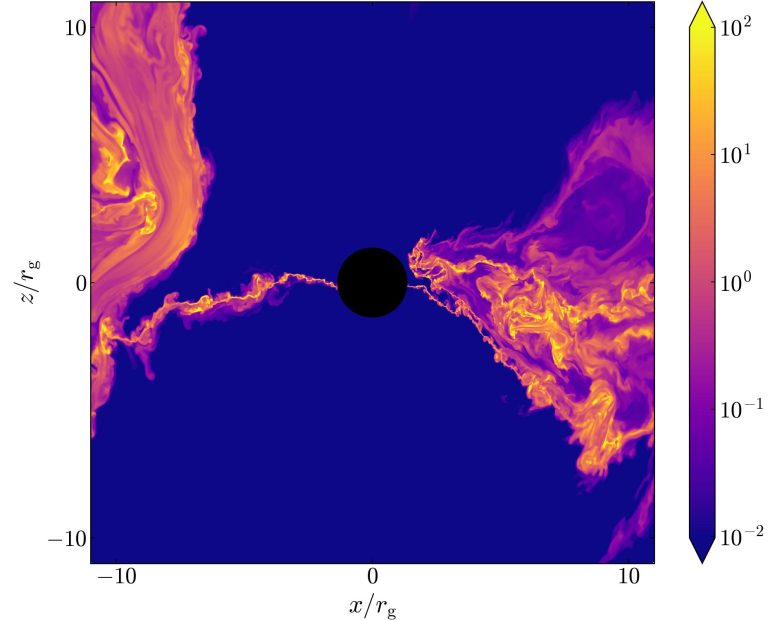Breaking and reconnecting magnetic field lines at the event horizon unleash the energy from a black hole’s magnetic field, speeding particles that cause intense flares, according to researchers at the Flatiron Institute and its partners.
The discoveries point to fascinating new possibilities for studying black holes.
Black holes do not necessarily exist in complete darkness.
Astronomers have discovered powerful light displays just beyond the event horizons of supermassive black holes, including the one at the center of our galaxy.
However, scientists could not determine the source of these flares other than the possible participation of magnetic fields.
Physicists claim to have answered the puzzle by using computer models of unprecedented power and resolution: energy produced near a black hole’s event horizon during the reconnection of magnetic field lines propels the flares, the researchers explain in The Astrophysical Journal Letters.
According to the new models, interactions between the magnetic field and material flowing into the black hole’s mouth lead the field to compress, flatten, break, and rejoin.
In the end, magnetic energy is used to slingshot hot plasma particles at near-light speed into the black hole or out into space.
Those particles may then immediately emit some kinetic energy as photons, providing an energy boost to adjacent photons.
The enigmatic black hole flares are made up of these powerful photons.

This model expelled the disk of previously infalling material during flares, clearing the space surrounding the event horizon.
This cleaning up might provide astronomers a clear picture of the usually hidden activities occurring close beyond the event horizon.
Bart Ripperda, study co-lead author and a joint postdoctoral fellow at the Flatiron Institute’s Center for Computational Astrophysics (CCA) in New York City and Princeton University stated:
“The fundamental process of reconnecting magnetic field lines near the event horizon can tap the magnetic energy of the black hole’s magnetosphere to power rapid and bright flares. This is really where we’re connecting plasma physics with astrophysics.”
https://www.youtube.com/watch?v=toC5C18d2Og
The new study was co-authored by Ripperda, CCA associate research scientist Alexander Philippov, Harvard University scientists Matthew Liska and Koushik Chatterjee, University of Amsterdam scientists Gibwa Musoke and Sera Markoff, Northwestern University scientist Alexander Tchekhovskoy, and University College London scientist Ziri Younsi.
Black Holes Thought to be Massive Chunks of Darkness
A black hole, as the name implies, emits no light.
So flares must come from beyond the event horizon of a black hole, which is the limit where the black hole’s gravitational pull becomes so intense that not even light can escape.
Orbiting and infalling material surrounds black holes in the form of an accretion disk, such as the one observed surrounding the M87 galaxy’s monster black hole.
This debris falls toward the event horizon, located near the black hole’s equator.

Jets of particles fly out into space at almost the speed of light from the north and south poles of some of these black holes.
Because of the physics involved, determining where flares emerge in the anatomy of a black hole is very challenging.
Black holes distort time and space while surrounded by tremendous magnetic fields, radiation fields, and swirling plasma… matter so hot that electrons separate from their atoms.
Despite the use of sophisticated computers, previous attempts could only mimic black hole systems at resolutions too low to discern the mechanism that fuels the flares.
Ripperda and his colleagues focused their efforts entirely on increasing the amount of detail in their simulations. They utilized computing time on three supercomputers: the Summit supercomputer at Oak Ridge National Laboratory in Tennessee, the Longhorn supercomputer at the University of Texas in Austin, and the Popeye supercomputer at the University of California, San Diego, run by the Flatiron Institute.
The project required millions of computation hours in total.
This processing power resulted in the highest-resolution simulation of a black hole’s surrounds yet created, with over 1,000 times the resolution of prior attempts.
The greater clarity provided the researchers with a previously unseen image of the events that lead to a black hole flare.
The process revolves on the black hole’s magnetic field, which has magnetic field lines that burst out from the event horizon of the black hole, generating the jet and linking to the accretion disk.
Previous simulations showed that material pouring into the equator of a black hole draws magnetic field lines toward the event horizon.
The dragging field lines continue to build up at the event horizon, eventually pushing back and preventing the inflow of material.
Ripperda believes that data from the newly launched James Webb Space Telescope, paired with those from the Event Horizon Telescope, will be able to establish if the process described in the new simulations is occurring and whether it affects photographs of a black hole’s shadow. We’ll have to wait and see, as Ripperda adds.
He and his colleagues are attempting to develop their simulations with more detail for the time being.
Source: SciTechDaily.com












Leave a Reply